Lens having an optically controlled peripheral portion and a method for designing and manufacturing the lens
a peripheral portion and lens technology, applied in the field of contact lenses and phakic intraocular lenses, can solve the problems of not providing vision correction, and soft contact lenses are not designed to provide optical control over the peripheral portions of lenses, so as to prevent or inhibit eye growth
- Summary
- Abstract
- Description
- Claims
- Application Information
AI Technical Summary
Benefits of technology
Problems solved by technology
Method used
Image
Examples
Embodiment Construction
[0025]In accordance with the invention, the peripheral portion of a contact lens or phakic IOC lens is provided with optical control by controlling the power profile of the peripheral portion of the lens. Typically, the central portion of the lens is also provided with optical control, but because the invention is directed primarily to the peripheral portion of the lens, the invention is not limited with respect to the power profile of the central portion of the lens. The power profile of the lens of the invention at the boundary of the central and peripheral portions meets certain boundary conditions necessary to ensure that the lens provides a desired or selected vision correction, as will be described below in detail with reference to FIGS. 3 and 4.
[0026]FIG. 1 illustrates a plan view of a contact lens 1 in accordance with an embodiment of the invention. The lens 1 comprises a central portion 10 and a peripheral portion 20. The peripheral portion 20 includes a blending portion 30...
PUM
 Login to View More
Login to View More Abstract
Description
Claims
Application Information
 Login to View More
Login to View More - R&D
- Intellectual Property
- Life Sciences
- Materials
- Tech Scout
- Unparalleled Data Quality
- Higher Quality Content
- 60% Fewer Hallucinations
Browse by: Latest US Patents, China's latest patents, Technical Efficacy Thesaurus, Application Domain, Technology Topic, Popular Technical Reports.
© 2025 PatSnap. All rights reserved.Legal|Privacy policy|Modern Slavery Act Transparency Statement|Sitemap|About US| Contact US: help@patsnap.com



